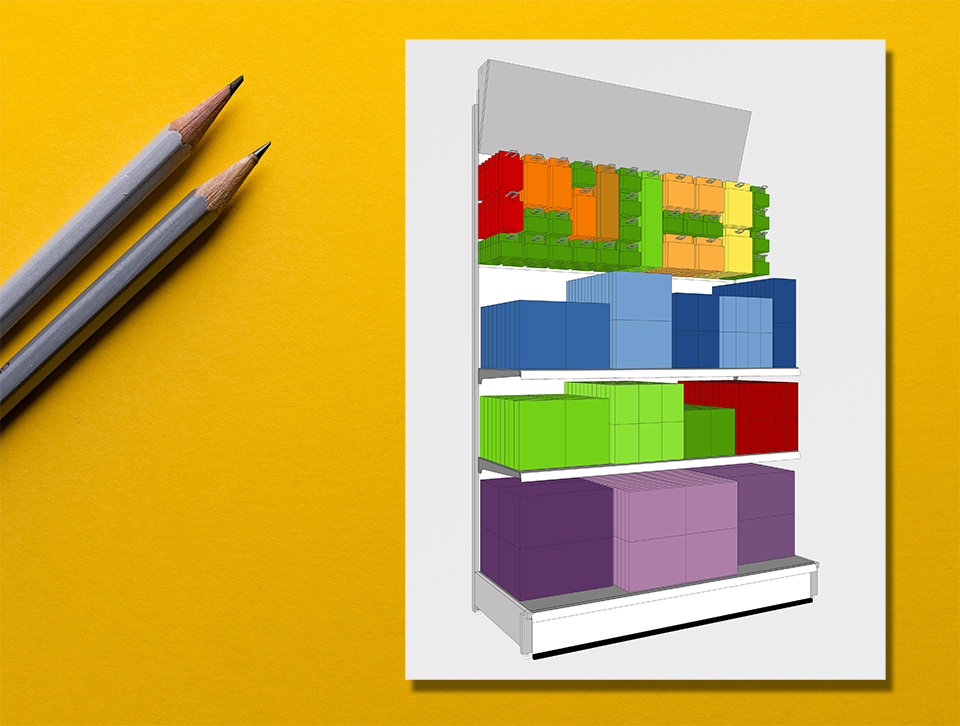
The principle of space management was invented and first used about 25 years ago as part of category management in the food segment of the retail trade. The first programs were accordingly tailored to the needs of food assortments.
Our idea started here: Space Management should also be available for other market segments – Non-Food, DIY, media, toys, healthcare. These segments would also benefit from optimized planning, evaluation and documentation of shelf loading.
Specifically, it was the requirement of a supplier of car accessories and sporting goods who supplied DIY stores with its product ranges: the placements were to be planned in a structured manner, the arguments of the supplier in listing discussions were to be supported by facts, and the internal and external processes for shelf furnishing were to be comprehensibly optimized.
It was quickly recognized: The available program packages were not suitable for the requirements of this industry. Form and type of products, the required design of presentation at the point of sale and the logistical conditions were not supported by the programs known at that time.
The principles of food optimization could not be applied 1:1 to the interests of non-food product presentation. Together with the company’s specialist departments, we then started designing the first suitable space management solution with extended features. Since then, we have been launching Space Management for non-food and non-standard presentations.
Challenges
What are the special challenges for non-food and non-standard presentations?
- extended product data, special classifications and correlations
- three-dimensional geometries and arrangements of the products
- complex fixtures and forms of presentation
- special logistic conditions
Product data and classifications:
Products should be able to be managed in several variants. Complementary products and competence goods should be considered. The products have additional identifiers and attributes.Product geometries:
Hammers, bicycle tires, badminton rackets are examples of products that cannot be adequately illustrated with simple product forms – such as boxes, cans, bottles. Those articles do not simply hang next to each other like blisters on pegwalls, but are hung into each other to save space. The space required is created by using the free space.Complex product carriers:
A hammer holder is much more complex than a simple pegwall hook. The hammer is not only simply positioned on this holder, but also tilted, i.e. rotated. The software should be able to take this into account automatically.Logistic boundary conditions:
While the Best-Before date and spoilage play a minor role, longer-term assessments of the hanging and the capital cost of high-quality products come into play. Demo articles and sales packaging should be distinguishable and differentiated. The supply chain of the special fixtures should also be taken into account.
Our task was to transfer the already known and well-introduced basic idea of space management into this more complex world. The standards should be observed, but all special features (geometry, data and algorithms, interfaces) should be taken into account. Our software should ensure simple operation while maintaining all degrees of freedom of design.
Our first solution
The first solution was a simple, two-dimensional planning program with a fixed range of functions and simple reporting. Our customer of those days was already able to achieve the first successes. The improved documentation of shelf planning has met with a very positive response from retailers.
The company itself, however, also received important information about impending stock shortfalls and overstocks and was able to save on many sample structures thanks to virtual shelf planning and satisfy trade customers with precisely prepared planning documents.
The next big improvement
In a second step, we were able to expand the solution into three-dimensional planning and integrate evaluation models and extended data structures. The simple planning tool had thus become an evaluation and optimization software.

XPace as current state of the art
With XPace, we now have a software that achieves and far exceeds the original objectives. New ideas and requirements have been added, as have new technological possibilities.
The art is and remains to recognize innovations and pour them into evolutionary software, not to deny old virtues, to remain compatible in the data structures, but nevertheless to honor the current state of development with our offer – and ideally: always to be one step ahead.
Basic priciples
So what came out of it?
- A multi-platform solution that does not rely on a single operating system
- …for both simple and complex 3D geometries and data structures
- …with support for all relevant interfaces and formats
- …with standard solutions plus comprehensive expansion options
- …with easy handling in the simple case, while giving full creative freedom
- …integrating well into business processes.
XPace translates the complex tasks of Space Management into an appropriate overall solution – easy yet not simplistic.
Perfection is achieved not when there is nothing more to add but when there is nothing left to take away. (Antoine de Saint-Exupéry)

Have we reached our goal?
With XPace, Space Management is applicable to complex situations and special requirements since 15 years. 3D geometries of products and fixtures, non-linear arrangements, complex dependencies and individual key figures are combined in a coherent concept of algorithms for space utilization, area evaluation and POS optimization.
We call it: Non-Linear Planogramming.
Other topics:
Use Cases • Reference projects

